 Hiss Me Deadly (Cat in the Stacks Mystery) by Miranda James
Hiss Me Deadly (Cat in the Stacks Mystery) by Miranda James Format: eARC
Source: supplied by publisher via Edelweiss
Formats available: hardcover, ebook, audiobook
Genres: cozy mystery, mystery
Series: Cat in the Stacks #15
Pages: 320
Published by Berkley on June 27, 2023
Purchasing Info: Author's Website, Publisher's Website, Amazon, Barnes & Noble, Kobo, Bookshop.org, Better World Books
Goodreads
Charlie and Diesel must catch a killer before he strikes another deadly note in this latest installment of the New York Times bestselling Cat in the Stacks Mysteries.
Charlie Harris remembers Wilfred “Wil” Threadgill as one of the outsiders during high school in Athena. Although Wil was a couple of years ahead of him and his friend Melba Gilley, Melba had a big crush on Wil, who dropped out after his junior year. An aspiring musician, Wil hit the road for California and never looked back. Wil eventually became a star, fronting a band and writing award-winning songs.
Coming back to Athena to work for two weeks with students in the college music department, Wil is now the big man on campus. Not everyone is happy to have him back, however. His entourage have been the target of several acts of petty harassment. At first they are easy for Wil to shrug off, but the incidents escalate and become more troubling. When one of the band members is killed Charlie worries that Melba, now deeply involved with the man at the center of the attacks, could be in deadly danger. It is up to Charlie and Diesel to find out who hates Wil Threadgill enough to silence his song . . . forever!
My Review:
I’m on my way to the American Library Association Annual Conference this week, which makes this the perfect time for another Cat in the Stacks cozy mystery. Why? Because both amateur detective Charlie Harris and his author, Miranda (Dean) James, are both librarians! The college in Charlie’s hometown, Athena, Mississippi, where Charlie works part-time as an archivist and rare books cataloger, probably doesn’t ever send him to the Annual Conference, but I’d say it’s a sure bet that when Charlie worked at the much larger Houston Public Library that they occasionally did – particularly on those occasions when the conference touched down in the Lone Star State – as it sometimes still does.
50something Charlie has an unfortunate – or fortunate for the readers of this series – tendency to find himself involved in murder. Not perpetrating it – as his large and in charge Maine Coon cat Diesel would never permit his human to ever fall to the dark side. Rather, Charlie all too frequently finds himself in a position to solve murders, or at least to make the attempt.
A fact which ALWAYS makes Detective Kanesha Berry wish he’d mind his own business, as he’s all too frequently working in parallel to her and very much without her sanction. His family and friends also wish he’d do a better job of letting sleeping dogs lie, as his willingness to stick his nose in where it doesn’t belong – at least when it comes to murder in his hometown – all too often put Charlie (and even Diesel) directly into the line of fire.
And so it proves in this case of one of Athena’s prodigal sons returning home to both a hero’s welcome and a twisted version of Agatha Christie’s And Then There Were None, with Charlie’s sister-from-another-mister, Melba Gilley, caught in the crossfire along with Charlie, Diesel, and the man she’s been pining over for entirely too long.
 Escape Rating B: I’ve missed Diesel, although now I have Tuna and he’s about half a Diesel in size, intelligence and purr volume. Diesel is always the best part of the Cat in the Stacks mystery series, even though he is not the detective like Joe Grey and is merely (although merely can’t truly encompass a cat Diesel’s size) a big, sweet cat.
Escape Rating B: I’ve missed Diesel, although now I have Tuna and he’s about half a Diesel in size, intelligence and purr volume. Diesel is always the best part of the Cat in the Stacks mystery series, even though he is not the detective like Joe Grey and is merely (although merely can’t truly encompass a cat Diesel’s size) a big, sweet cat.
Howsomever, Diesel frequently serves as an emotional support cat during Charlie’s adventures – and not just for Charlie. A LOT of the characters in this entry in the series need more than a bit of feline TLC to get them through the trauma.
The starting point is a deadly take on “small town child makes good” as Wilfred “Wil” Threadgill is coming back home to Athena after 40 years of musical success, both as the leader of his own band and an Oscar-worthy movie soundtrack composer.
But Wil didn’t simply leave Athena and never look – or come – back over the years. He ran away – from town, from home, from his senior year in high school, and especially from the musical group that had formed around him and his friends. A musical group that was starting to see a fair amount of local success, and had a promising future – until Wil, the driving force behind that success bailed on Athena and left them high and dry and in the lurch.
It’s clear from the outset that someone in town isn’t exactly happy to see Wil, but their method of attack is to start attacking people around the man, and not the man himself. As the injuries mount and the bodies continue falling, Melba tries to protect her old flame, Charlie stays on the case to look out for Melba, while Detective Berry searches for a killer who seems to be holding an old grudge while hiding in plain sight.
I had a lot of fun reading this one – as usual. Charlie Harris is authentically one of us librarians, and Diesel is just as authentically a very big cat. Charlie’s life reads like a comfortable slipper that produces a sigh of relief whenever I put it on, because so much of his work and career is so familiar and rings true. Very much on the other hand, he has a tendency to find himself in interesting trouble, much like Jessica Fletcher in Murder, She Wrote.
This particular entry in the series relies on a bit of prior knowledge of Charlie’s life to date and the family of both birth and choice that he shares it with, as the ‘B’ plot of the story involves both Charlie’s attempts to get his fiancée to set a date for their wedding as well as a bit of trouble in the paradise of his son’s marriage. It’s not necessary to have read the entire series to get stuck into this entry, but one or two would be helpful – and the whole thing is a lovely, cozy read.
The case itself, while it isn’t a fair play mystery as there aren’t nearly enough clues to figure it out until very late in the game, is still more than interesting enough to follow between the story of the local boy makes good returning, the very old, very deep and very justified grudge, and the second set of crimes that just makes solving the puzzle that much more complicated.
So if you like small town cozies with engaging amateur detectives assisted by diverse ‘Scooby gangs’ accompanied by really adorable and personable animals, the Cat in the Stacks series might be your reading catnip. It certainly is mine!

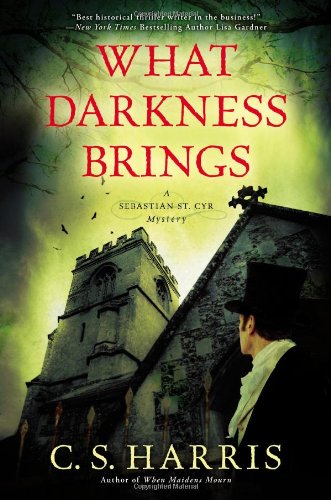 What Darkness Brings (Sebastian St. Cyr, #8) by
What Darkness Brings (Sebastian St. Cyr, #8) by 
 Escape Rating A: It’s not much of a surprise that after
Escape Rating A: It’s not much of a surprise that after 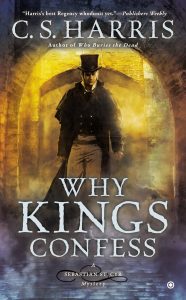 The way the murder, the theft plot and the real history branched and intertwined made this entry in the series one hell of a wild ride, while still tying up loose ends from previous entries and opening up entirely new fields of questions for future books in the series – some of which have admittedly been answered by the point where the series as a whole rests – hopefully temporarily – after
The way the murder, the theft plot and the real history branched and intertwined made this entry in the series one hell of a wild ride, while still tying up loose ends from previous entries and opening up entirely new fields of questions for future books in the series – some of which have admittedly been answered by the point where the series as a whole rests – hopefully temporarily – after 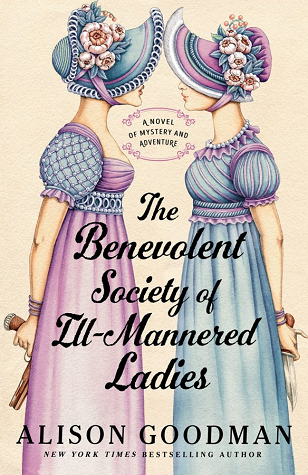 The Benevolent Society of Ill-Mannered Ladies (The Ill-Mannered Ladies, #1) by
The Benevolent Society of Ill-Mannered Ladies (The Ill-Mannered Ladies, #1) by 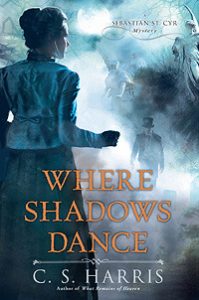 Both the Colebrook sisters and St. Cyr are conducting their investigations during the Regency period, in this book specifically 1812 – which is also the year in which books 4 through 8 of the St. Cyr series (
Both the Colebrook sisters and St. Cyr are conducting their investigations during the Regency period, in this book specifically 1812 – which is also the year in which books 4 through 8 of the St. Cyr series (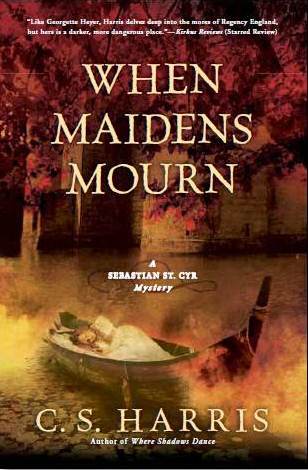 When Maidens Mourn (Sebastian St. Cyr, #7) by
When Maidens Mourn (Sebastian St. Cyr, #7) by  The legend of King Arthur has always loomed large over Britain, but even more so at times when the current monarch is less than popular. Or, as in the case of the corpulent, aging, spendthrift Prinny, Prince Regent for his mentally incapacitated father George III, not just unpopular but downright detested for his endless need for more money and therefore higher taxes to maintain his profligate lifestyle AND continue to prosecute Britain’s seemingly endless war with Napoleon and France.
The legend of King Arthur has always loomed large over Britain, but even more so at times when the current monarch is less than popular. Or, as in the case of the corpulent, aging, spendthrift Prinny, Prince Regent for his mentally incapacitated father George III, not just unpopular but downright detested for his endless need for more money and therefore higher taxes to maintain his profligate lifestyle AND continue to prosecute Britain’s seemingly endless war with Napoleon and France.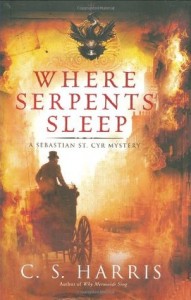 Escape Rating A+: The
Escape Rating A+: The 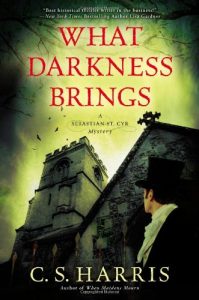 At least, it’s uncertain at this particular point in the series. I began reading St. Cyr almost 20 years ago, at the beginning with
At least, it’s uncertain at this particular point in the series. I began reading St. Cyr almost 20 years ago, at the beginning with  The Bride Wore White (Burning Cove, California, 7) by
The Bride Wore White (Burning Cove, California, 7) by  The help of someone who both accepts the supernatural community AND knows how to get things “fixed”. Prudence goes to Burning Cove California to just about throw herself on the mercy of Luther Pell, the owner of the exclusive Burning Cove Hotel and one of the central characters of both the place and the series that began with
The help of someone who both accepts the supernatural community AND knows how to get things “fixed”. Prudence goes to Burning Cove California to just about throw herself on the mercy of Luther Pell, the owner of the exclusive Burning Cove Hotel and one of the central characters of both the place and the series that began with  Burning Cove as a place and a series, and The Bride Wore White in particular, have all the elements to mix spellbinding suspense, a satisfying mystery and a delightful romance into one delicious cocktail of a story.
Burning Cove as a place and a series, and The Bride Wore White in particular, have all the elements to mix spellbinding suspense, a satisfying mystery and a delightful romance into one delicious cocktail of a story. Happy Place by
Happy Place by  Escape Rating B+: I went into Happy Place hoping for another
Escape Rating B+: I went into Happy Place hoping for another 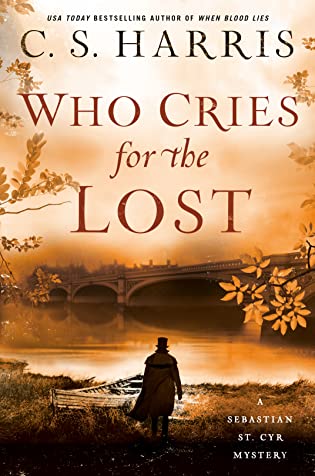 Who Cries for the Lost (Sebastian St. Cyr, #18) by
Who Cries for the Lost (Sebastian St. Cyr, #18) by 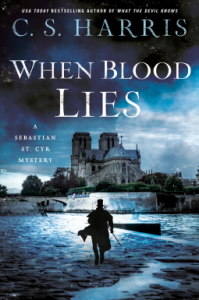 St. Cyr served as a cavalry officer and sometimes an undercover operative in the worst places and days of the Napoleonic Wars. Wars that are not quite over when this entry in the series takes place in June of 1815, barely a season after the events of the previous book in the series, the excellent
St. Cyr served as a cavalry officer and sometimes an undercover operative in the worst places and days of the Napoleonic Wars. Wars that are not quite over when this entry in the series takes place in June of 1815, barely a season after the events of the previous book in the series, the excellent 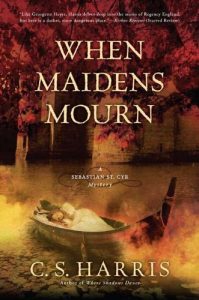 What kept this reader going through the story was the skill with which the two threads were woven together. Was Sedgewick killed for his many, many misdeeds? Or was he killed to stop, or conceal, treason or espionage? Or was it purely revenge? Or all of the above? Getting that question answered while exploring St. Cyr’s world made for a compelling read. As it has every single time since
What kept this reader going through the story was the skill with which the two threads were woven together. Was Sedgewick killed for his many, many misdeeds? Or was he killed to stop, or conceal, treason or espionage? Or was it purely revenge? Or all of the above? Getting that question answered while exploring St. Cyr’s world made for a compelling read. As it has every single time since  A Tempest at Sea (Lady Sherlock #7) by
A Tempest at Sea (Lady Sherlock #7) by  Because the detective who just so happens to be aboard the Provence is none other than the intelligent and implacable Inspector Brighton, a Scotland Yard CID investigator that Holmes got the better of – read as exposed that the Inspector’s implacability had sent him barking up the wrong suspect tree – in
Because the detective who just so happens to be aboard the Provence is none other than the intelligent and implacable Inspector Brighton, a Scotland Yard CID investigator that Holmes got the better of – read as exposed that the Inspector’s implacability had sent him barking up the wrong suspect tree – in 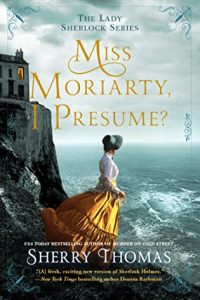 That niggle aside, the mystery was still fascinating. I loved watching Charlotte work while hiding behind the kind of character masking that the original Holmes did so well – instead of hiding behind Sherlock Holmes himself.
That niggle aside, the mystery was still fascinating. I loved watching Charlotte work while hiding behind the kind of character masking that the original Holmes did so well – instead of hiding behind Sherlock Holmes himself.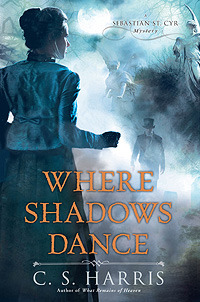 Where Shadows Dance (Sebastian St. Cyr, #6) by
Where Shadows Dance (Sebastian St. Cyr, #6) by  I was hooked back in 2005, and devoured the first five books in the series as they were published. Until, as so many things do, the series got caught up in the black hole of “so many books, so little time” and I stopped following until I was asked to
I was hooked back in 2005, and devoured the first five books in the series as they were published. Until, as so many things do, the series got caught up in the black hole of “so many books, so little time” and I stopped following until I was asked to  And I love the way the known historical conflicts of the time, both in government in England and in the wider world, are neither ignored nor brushed aside but instead inform every aspect of the mystery and give it depth and substance. All while a murder is committed, the crime is investigated, and evil gets its just desserts even as the story acknowledges that there are plenty of other – and often worse – evils afoot in that wider world that Devlin has yet to deal with. If he can.
And I love the way the known historical conflicts of the time, both in government in England and in the wider world, are neither ignored nor brushed aside but instead inform every aspect of the mystery and give it depth and substance. All while a murder is committed, the crime is investigated, and evil gets its just desserts even as the story acknowledges that there are plenty of other – and often worse – evils afoot in that wider world that Devlin has yet to deal with. If he can. Book Lovers by
Book Lovers by  Two years later, unbeknownst to each other, in the middle of trips that they’ve each been separately strong-armed into, they run into each other in the tiny town of Sunshine Falls, NC, to discover that their enmity isn’t really all that strong, but their bantering snarkitude is excellent.
Two years later, unbeknownst to each other, in the middle of trips that they’ve each been separately strong-armed into, they run into each other in the tiny town of Sunshine Falls, NC, to discover that their enmity isn’t really all that strong, but their bantering snarkitude is excellent.